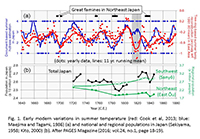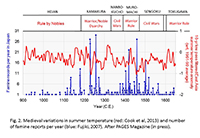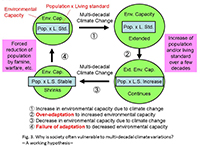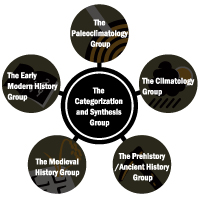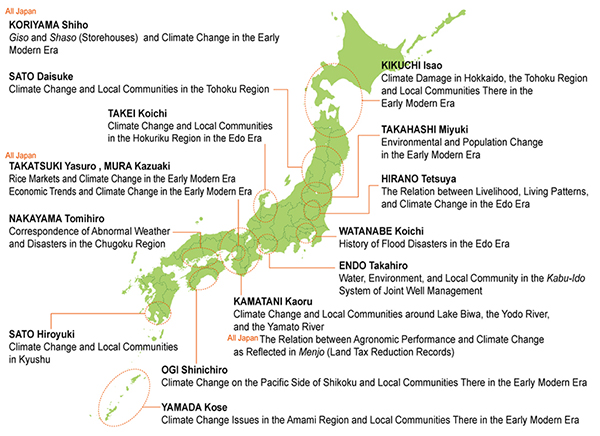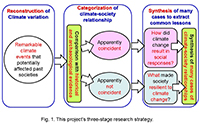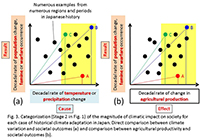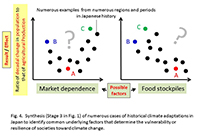- HOME
- > ABOUT
ABOUT THE HISTORICAL CLIMATE ADAPTATION PROJECT
Historical Climate Adaptation Project
What should we do when we confront rapid environmental and/or climatic changes? The most important task in global environmental studies is to find methods for adapting to change, not just mitigating it. This project intends to identify such methods through precise paleoclimatic, historical, and archaeological reconstructions of the many examples of abrupt climate change and the diverse societal responses those engendered over the long course of Japanese history. By categorizing historical society–climate relations and synthesizing findings from many case studies, this project also seeks to identify general social characteristics or modes associated with tolerance or vulnerability to abrupt changes.
To date, many paleoclimatologists and historians have noted apparent coincidences between historical events and climate change, speculating that the former might have been caused by the latter. In particular, recent paleoclimatological studies using tree ring and speleothem records have revealed a close relationship between multi-decadal climate variability and regional social collapse throughout the world, including Japan (Figs. 1, 2).
Climatic variations in the past, of course, are not the same thing as contemporary anthropogenic environmental changes. However, we believe that past societal responses to climate change, especially to multi-decadal climatic variation (Fig. 3), nonetheless have relevance to global environmental change. Human societies often rely excessively on particular resources or technologies such as petroleum or nuclear power (this is known as overadaptation).
Therefore, when these resources or technologies become unavailable for one reason or another, society is faced with a problem. Similarly, human societies that have optimized their agricultural strategies for particular climate conditions over a period of decades cannot easily adapt to drastic climate change. We believe that common patterns of overadaptation and resulting failure to adapt to new conditions can be found both in today’s global environmental challenges and in historical examples of the relationship between climate and society.
This project consists of 6 research groups. The purpose of the Paleoclimatology Group and the Climatology Group is to accurately reconstruct and understand past changes in climate. The Prehistory / Ancient History Group, the Medieval History Group, and the Early Modern History Group aim to analyze the historical relationship between climate and society in their respective periods. Finally, the Categorization and Synthesis Group will formulate the overall conclusions of the project. Each of the six groups pursues its research in collaboration with the others in order to achieve the project’s overall purpose.
Paleoclimatology Group
This research group is reconstructing climate variations in Japan over the past several thousand years using various proxy records such as tree rings, coral rings, old documents, and marine sediments. Of the proxies, tree rings are the most important because 70% of land in Japan is covered by forest and tree-ring samples can be collected not just from living trees but also from archaeological specimens. By analyzing tree-ring oxygen isotope ratios, it is possible to reconstruct precipitation in summer, the growing season for trees, at an annual time resolution. In the cold regions such as north Japan and mountainous areas, summer temperatures can also be reconstructed from maximum density in tree rings. Although we have already established a tree-ring oxygen isotope chronology going back 4300 years, we are continuously trying to improve its horizontal coverage because a spatially coordinated tree-ring dataset makes it possible to precisely reconstruct past changes in atmospheric circulation patterns such as the Baiu front and Yamase, which influenced agricultural production, and with reliable regional chronologies, which are needed to precisely date archaeological samples of wood.
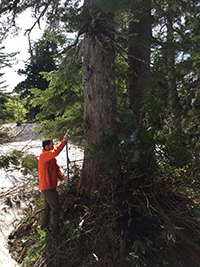
Sampling with increment borers
It is not possible to reconstruct past climate at a daily time resolution from tree rings, but seasonal variations in precipitation may be inferred from intra-ring oxygen isotope measurements. Therefore, we are collaborating with the Early Modern History Group to reconstruct daily weather conditions using old diaries all over Japan. We are also collaborating with the Climatology Group in innovative research aimed at reconstructing daily atmospheric circulation patterns in the Early Modern period by incorporating diary-based weather data into a data-assimilation general circulation model.
In addition, coral rings are being used to reconstruct sea surface temperature and salinity. Because in general tree rings are not useful for reconstructing long-term (multi-century) climate variations, we are utilizing biomarker (alkenone) composition in inland bay sediment cores around Japan to reconstruct long-term variations in summer sea surface and air temperatures. In short, the role of this group is to provide the historians and archaeologists affiliated with the project with past climate records that are as precise as possible given the strengths and limitations of individual paleoclimate proxies.
Climatology Group
Past climate inferred from heavy water
Did you know that there are two types of water, “heavy” and “light”? Water molecules containing 2H (Deuterium) and 18O are known as heavy water, while those without 2H and 18O are called light water. Because the behavior of heavy water is different from that of light water during phase transitions, determining the ratio of heavy water in samples makes it possible to clarify climatic conditions or details of the hydrological cycle at various spatio-temporal scales. In fact, such research has been conducted since the 1950s.
However, it is not easy to draw conclusions from the heavy water in a sample from a particular location or time because it is inevitably affected by the global hydrological cycle and accompanying phase transitions. Therefore, in order to extract meaningful information from the water isotope ratio, researchers typically determine some simplified empirical relationship between it and environmental factors such as temperature and/or precipitation. However, our group is approaching this problem from an entirely new perspective, asking what causes (in the hydrological cycle) are consistent in spatio-temporal or physical terms with the observed results (isotope ratios). A new method called off-line data assimilation has recently been developed based upon this approach. Because we can save on computer costs and make use of annual-resolution climate data with off-line data assimilation, this method fits the purpose of our project very well.
To start with, we reconstructed the global distribution of air temperature and precipitation for each year in the 20th century with off-line data assimilation using water isotope ratios alone, verifying the results against instrumental meteorological observations. The reconstruction gave an especially accurate representation of the El Nino Southern Oscillation (ENSO), showing the method’s potential applicability to the period before 19th century. We have also confirmed that it is possible to improve the accuracy of past climate reconstruction by extending observed and proxy records in collaboration with other research groups in this project. Heavy water is thus emerging once more into the limelight through the use of up-to-date climate models and data assimilation technology. Welcome back, heavy water!
Prehistory/Ancient History Group
Because this group is investigating a period from which few documentary records survive in Japan, we are reorganizing existing data from archaeological site reports into a format that fits the purpose of our project. Specifically, we are using information from site reports to reconstruct spatio-temporal variations in the number of dwellings and tombs from the Yayoi and Kofun periods in order to directly compare those variations with paleoclimate data produced by the Paleoclimatology Group. This type of comparison will allow us to link settlement dynamics and climate change to show, for example, that frequent floods pushed the location of villages towards highlands.
In addition to compiling vast amounts of data from archaeological excavations, we are also applying a new dendrochronological tool using tree-ring cellulose oxygen isotope measurements to excavated wooden materials, mainly composed of hardwoods, in order to obtain precise calendar ages for archaeological remains which were previously dated only on the basis of relative earthenware chronologies or, in some cases, radiocarbon measurements. We have determined highly accurate calendar ages for many excavated wood samples obtained from local archaeological operation centers all over Japan by comparing their tree-ring oxygen isotope time-series with our master chronology.
Although formerly it was difficult or impossible to date degraded samples, we have improved our cellulose extraction methods through trial and error, making it possible to quickly produce large volumes of dendrochronological data. For example, at the Ikeshima Fukumanji Site in Osaka, which is known for its well-preserved remains of Yayoi Period rice paddies, precise dating of numerous, carefully-excavated wooden piles allows us to reconstruct in detail the history of the rice paddies and irrigation system. Adding an absolute chronology based on tree-ring oxygen isotope measurements to the known relative chronology of stylistic changes in irrigation dams and waterways will provide us with a potent new tool for investigating how people during prehistory responded to climate change.
Medieval History Group
This group is investigating how medieval Japanese society adapted to climate variation by comparing paleoclimate data on air temperature and precipitation with societal changes inferred from historical documents. We are pursuing two research strategies. One is to select a particular period and investigate spatial patterns of societal adaptation to climate change throughout Japan for that period. The other is to select some particular small area such as a medieval estate (shoen) and elucidate temporal variations in society with respect to climate variations throughout the entire medieval period.
In the former case, we compare the numerous records of medieval weather-related disasters such as floods, droughts, cold weather, and accompanying famines contained in local histories as well as Hisashi Fujiki’s Chronological Table of Meteorological Disaster History in Medieval Japan (2007) with paleoclimate data in order to elucidate the relationship between climate change and social conditions. For example, we are investigating why abrupt, large climate variations caused terrible famines in some periods whereas similar variations in other periods had no discernible effect.
Regarding the latter case, we are focusing on the area around Katsura River to the west side of the old capital, Kyoto, which was the location of Kami (Upper) Kuze and Shimo (Lower) Kuze, two estates (shoen) owned by Toji Temple. The rich historical record for this area provides us with information about both the temple proprietor and local conditions on the estates . We therefore expect to be able to elucidate, from the viewpoint of both the rulers and the ruled, how local society in the western suburbs of Kyoto responded to the frequent floods and droughts of the Muromachi period.
One of the most important research strategies of the Medieval History Group is to apply a quantitative approach to the analysis of historical documents. We mainly utilize currently available medieval documentary databases to make direct graphic comparisons between the annual number of records related to climate disasters and proxy-based reconstructions of air temperature and precipitation. Previously, historians have assumed that variations in the number of surviving historical records are dependent on incidental or random causes, so that they have not attempted quantitative analyses based on numbers of records. However, the new annual-resolution climate data on temperature and precipitation make it possible to conduct comparisons between this paleoclimatic data and the number of records concerning, for example, floods and droughts, that survive for a given year. We have found significant correlations that substantiate the viability of conducting quantitative analyses of variation in the number of historical records. Hence, we will attempt to elucidate the characteristics of Japanese medieval society from the viewpoint of adaptation to climate change through interdisciplinary collaboration between document-based historiography and paleoclimatology.
Early Modern History Group
In the early modern period, the literacy rate was relatively high for Japanese people of all social classes, who consequently left uncountable numbers of documents, reports, maps, and diaries for posterity. The Early Modern History Group will use these sources as clues to elucidate the relationship between climate variation and societal response during the period in question.
To date, Japanese historians of the early modern era have studied the structure of human society from various viewpoints including political history, economic history, village history, urban history, etc. They have also analyzed the various issues stemming from people’s relationship with the natural environment, including natural disasters and famines, land development and disaster recovery, agriculture and other livelihoods, religious faith, etc. In recent years research activity in these areas has expanded under the rubrics of “disaster history” and “environmental history.”
In this way, rich and diverse research by historians has helped to clarify the relationship between nature and society in the early modern period. However, all of this research is based on historical records, the mainstay of the professional historian. In this project, we will augment the results of previous historical research by incorporating up-to-date paleoclimatological data, which offers a fresh perspective that will stimulate further research.
The Early Modern History Group will proceed to elucidate the responses of early modern society to climate variations in two stages, one looking at Japan as a whole and the other based on regional case studies. By pursuing analysis that combines country-wide trends with specific cases, it should be possible to arrive at more universal conclusions regarding the relationship between climate and society in early modern Japan.
Through detailed and holistic investigations on the relationship between climatic change and early modern society, we hope to advance research that will not only suggest a new understanding of early modern Japanese society, but will also provide hints for considering our relationship with the natural environment in today’s world.
Please look at the map for information on the specific research localities and subjects of members of the Early Modern History Group.
Categorization and Synthesis Group
As a whole, the Historical Climate Adaptation Project will take place in three stages (Fig. 1): (1) reconstructing and understanding past climate variations during the last several millennia in Japan at high temporal and spatial resolutions; (2) categorizing the relationship between society and climate in each region and period by means of detailed chronological comparisons of climate variation and societal response; (3) synthesizing the various historical cases in order to identify common factors that determine the resilience or vulnerability of human societies to climate change irrespective of time or location. Comparison of high-resolution paleoclimate data with information from Japan’s voluminous historical and archaeological record makes it possible not only to elucidate cause-and-effect relationships when climate apparently influenced society but also to identify cases where climate variation had no discernible social impact.
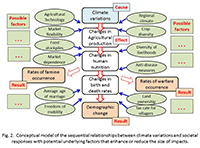
Fig.2
Conceptual model of the sequential relationships between climate variations and societal responses with potential underlying factors that enhance or reduce the size of impacts.
In the first stage, high-resolution paleoclimate data based on tree rings, documents, sediments, coral rings, and speleothems will be synthesize to ensure the accuracy of climate reconstructions in and around Japan. The reconstructions will be further evaluated by climate analysts and modelers in order to understand the modes and mechanisms of climate variations in the past. In the second and third stages, we will utilize both narrative and statistical approaches to categorize and synthesize examples of the relationship between climate and society in Japanese history. Historians and archaeologists in the Prehistoric / Ancient History Group, the Medieval History Group, and the Early Modern History Group will study individual cases of societal response to climate variation by traditional narrative means, but all cases will also be categorized statistically according to quantitative relationships between climate variations (cause) and societal outcomes (result) (Fig.2).
The magnitude of climatic impact on society, given by the ratio of the result against the cause, will be further compared with various social, economic, and cultural parameters (factors) that enhanced or reduced climatic impact on society, in order to find common factors determining societal resilience or vulnerability to climate change (Figs. 3, 4). The function of the Categorization and Synthesis Group is to carry out this statistical analysis in collaboration with the other groups.



